Rubber Mats Under Refrigerators: Benefits and Guide
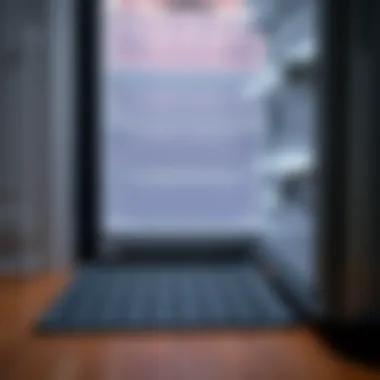
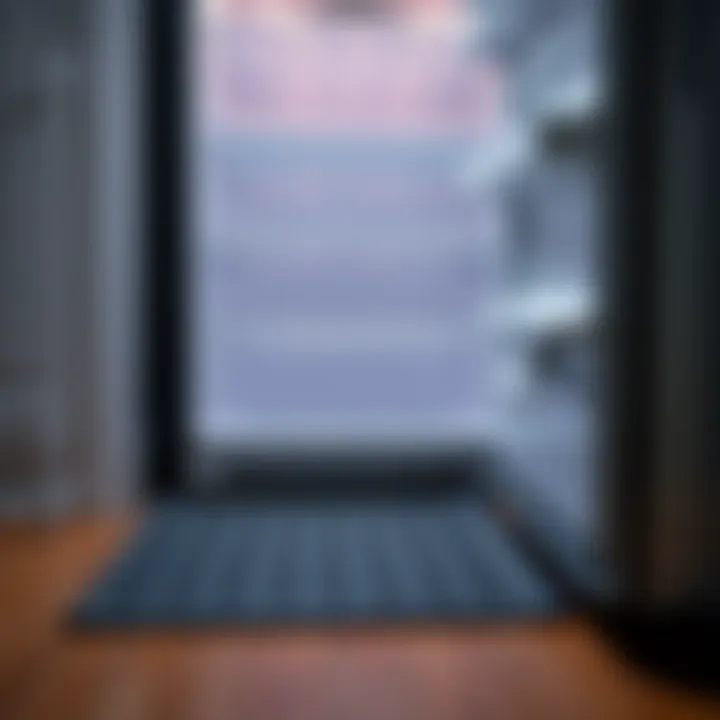
Intro
When it comes to our kitchen spaces, we often overlook certain staples that play a crucial role in maintaining functionality and aesthetics. One such item is the rubber mat that resides underneath refrigerators. These mats may seem inconspicuous, but they serve several vital purposes, from mitigating vibrations to preventing unwanted moisture damage. Understanding these underlying functions reveals how strategic choices in home accessories can enhance the longevity of appliances and safeguard flooring.
Modern kitchens, often teeming with activity, hold room for innovation in both design and functionality. With the rise in open-concept living, the need for effective solutions has become all the more pertinent. Rubber mats have gained traction among homeowners and designers alike, making them a topic worth exploring in depth.
This article aims to uncover the myriad ways rubber mats can benefit your refrigerator setup. We’ll explore their practical functions, varieties available in the market, how to select the right one, necessary maintenance routines, and possible alternatives.
By the end, we hope you’ll find yourself fully equipped with insights that not only elevate your home’s practical setup but also contribute to a sleek, design-savvy kitchen environment.
Key Functions of Rubber Mats Under Refrigerators
Vibration Absorption
One of the most significant advantages of placing a rubber mat beneath your refrigerator is its ability to absorb vibrations. Refrigerators, particularly older models or those that operate with a compressor, can be noisy and may cause floor scraping noises or even damage over time due to vibrations. A rubber mat can significantly dampen these disturbances, ensuring that your appliance runs quietly and efficiently. This is particularly vital in open-plan homes where sound travels freely.
"Incorporating rubber mats is a savvy choice to keep the peace in busy households, transforming a clunky beast of a fridge into a serene addition to the kitchen."
Moisture Control
Another practical reason to invest in a rubber mat is its role in moisture management. Refrigerators can sometimes leak or sweat, which can lead to water pooling and subsequently causing floor damage. Rubber mats are generally resistant to water, acting as a protective layer that prevents liquid from reaching your flooring. This not only preserves the integrity of various flooring types but also saves you from potential repair costs down the line.
Floor Protection
Moreover, rubber mats can effectively shield your floor from scratches, dents, and stains. Whether it's a hardwood floor that's easily marred or tiles that are prone to cracking, the padding offered by rubber can be a game changer. It’s often the unsung hero in preserving the beauty of your kitchen space.
Types of Rubber Mats
Rubber mats come in various shapes, sizes, and thicknesses, each tailored for specific uses. When choosing a mat for under your refrigerator, consider the following types:
- Heavy-Duty Mats: These are thicker and specifically designed to withhold the weight of larger appliances.
- Anti-Slip Mats: Ideal if stability is a concern; they often feature ribbed surfaces to prevent slipping and sliding.
- Drainage Mats: Equipped with holes to permit water drainage, these mats are perfect for environments prone to spills.
When selecting a mat, it's essential to ensure it fits well under your appliance without being visible from the front. A fitting mat complements your kitchen's aesthetic while delivering the desired functionality.
Maintenance Considerations
To get the most out of your rubber mat, consider a few key maintenance practices:
- Regular Cleaning: Dirt and grime can build up on mats over time. Regular sweeping and occasional mopping can keep the area hygienic.
- Inspect for Wear and Tear: Since mats bear significant weight, inspect them regularly for signs of deterioration. Replace them promptly if you notice damage.
- Avoid Harsh Chemicals: Stick to mild cleaners to prevent degrading the rubber material.
Ending
Rubber mats under refrigerators, often overlooked, provide essential benefits that enhance the functionality and longevity of your appliances while protecting your kitchen floor. They embody a combination of practicality and utility, making them an indispensable accessory in any modern kitchen. With the right knowledge about types, functions, and maintenance, homeowners can make informed decisions that contribute positively to household maintenance.
For more detailed resources and discussions, check out links like Wikipedia and Britannica. Explore community insights on platforms like Reddit for shared experiences and tips.
Preamble to Rubber Mats Under Refrigerators
In the hustle and bustle of modern kitchens, appliances play a crucial role in our daily lives. Among them, refrigerators stand out as perhaps the most essential piece, keeping our food fresh and our drinks cool. However, the often overlooked companion in this appliance space is the rubber mat that sits beneath it. Understanding the importance of rubber mats under refrigerators is not just for aesthetics; it’s about enhancing functionality, ensuring longevity, and safeguarding our flooring. This article will unpack these aspects, shining a light on why these mats deserve more attention.
Purpose of Using Rubber Mats
Rubber mats serve several important purposes in the context of refrigeration. Primarily, they are designed to absorb vibrations caused by the refrigerator’s compressor and fan. This absorption not only minimizes noise but also prevents any potential wear and tear on floors beneath, which can be a hidden cost over time.
Additionally, these mats provide a buffer against moisture. Refrigerators can sweat or leak, especially during humid conditions or when they are first installed. A rubber mat acts as a barrier, preventing water from seeping into wooden floors, which might otherwise lead to warping or mold growth.
Furthermore, they are useful for stability. If you have a slightly unlevel floor, having a rubber mat can help the refrigerator sit more evenly, reducing wobbling and ensuring consistent performance.
Common Problems Addressed
Installing a rubber mat under your refrigerator is a straightforward solution to multiple common issues faced by homeowners:
- Vibration and Noise: The continuous humming and vibrations from a refrigerator can be a nuisance. Rubber mats significantly lessen this disturbance, providing a quieter environment.
- Floor Damage: Whether your flooring is hardwood, tile, or laminate, the weight of a refrigerator can leave marks or scratches. A rubber mat protects against this damage, preserving the integrity of your flooring.
- Moisture Management: Not just a matter of convenience, managing moisture is crucial. Excess water can seep into floors and damage them, leading to expensive repairs. Rubber mats help contain spills, giving you peace of mind.
- Stability Issues: Often, refrigerators may wobble due to uneven flooring. A rubber mat aids in creating a stable base, thereby enhancing the appliance’s lifespan and effectiveness.
Ultimately, by understanding these purposes and problems, one can appreciate the significance of rubber mats in creating a well-functioning kitchen environment. They are affordable solutions with long-term benefits that can safeguard both your appliances and your home.
Material Properties of Rubber Mats
Understanding the material properties of rubber mats is crucial when considering their role under refrigerators. These mats serve not only as a base but also bring a host of benefits that enhance the functionality and longevity of the appliance. When selecting a mat, it’s not just about aesthetics; the composition and characteristics play big roles in performance.
Durability and Longevity


Rubber mats are primarily known for their durability. They are often made from natural or synthetic rubber which makes them resilient against wear and tear. This resistance means that with minimal maintenance, these mats can last several years, even under the constant vibration of a running refrigerator.
For homeowners or designers looking for a sustainable solution, it’s noteworthy to mention that quality rubber mats do not easily degrade under typical conditions of household use. They can withstand various environmental aspects, like temperature fluctuations, without developing cracks or tears. Indeed, investing in a good rubber mat could save you money in the long run since you won’t have to replace them frequently.
Some of the factors influencing the longevity include:
- Material Quality: Higher-grade rubber often performs better and lasts longer.
- Exposure to Elements: Mats placed in humid areas or direct sunlight might have a shorter lifespan unless they are specifically designed to resist such conditions.
- Weight of the Refrigerator: Heavier units may compress the mat over time, but a durable mat will maintain its structural integrity.
Water and Stain Resistance
Another essential characteristic of rubber mats is their water and stain resistance. Refrigerators can inadvertently leak, and any moisture underneath can lead to damage not only to the mat but also to your flooring. Rubber naturally has a waterproof quality which helps prevent dampness from seeping through.
In addition to protecting floors from moisture, rubber mats tend to be easier to clean than other materials. Spills and splatters can usually be wiped away without leaving any residual stains. For example, sauces or liquids from the fridge can be quickly cleaned off without worry. Here are some advantages of their water and stain resistance:
- Simplified Cleaning: Regular maintenance only requires a quick mop or a damp cloth.
- Prevention of Mold and Mildew: Keeping moisture at bay stops fungi and bacteria from taking root. This feature is essential for maintaining a healthy kitchen environment, especially in areas that might be prone to mold.
- Enhanced Appearance: While functionality is key, it’s also important for homeowners to want their kitchens to look pristine. A rubber mat that remains stain-free contributes positively to the overall aesthetic of the space.
In summary, the material properties of rubber mats are fundamental to their effectiveness. Durability ensures that they can withstand the test of time, while water and stain resistance help maintain cleanliness and protect your valuable flooring. Proper selection based on these attributes can lead to a long-term, hassle-free experience in your kitchen.
Benefits of Using Rubber Mats Under Refrigerators
Rubber mats may seem like a minor accessory in the grand scheme of appliance management, but their benefits are far from trivial. For homeowners and designers alike, understanding these advantages can lead to a more orderly and functional kitchen space. In essence, rubber mats serve multiple purposes that contribute to an enhanced environment beneath what is often one of the largest appliances in the home—the refrigerator.
The importance of rubber mats cannot be overstated, especially considering the wear and tear that refrigerators impose on flooring and the potential hazards posed by vibrations and moisture. Rubber mats are not only practical but are a smart investment for long-term kitchen maintenance. Let's delve deeper into the specific benefits these mats provide, which help maintain a tidy and problem-free kitchen.
Vibration Absorption and Noise Reduction
Refrigerators are notorious for being noisy, especially older models that struggle to keep their engines cool. They can produce vibrations that reverberate through floors, creating disturbances in your home environment. By placing a rubber mat beneath the fridge, you significantly reduce the intensity of these vibrations.
- Why is this important? A quieter kitchen contributes to a more calming environment, particularly in homes where the kitchen is a central gathering spot.
- How does it work? Rubber has natural elastic properties. Unlike wood or tile, rubber absorbs and dampens the vibrations produced by the refrigerator’s compressor and cooling mechanisms. You could say that rubber acts as a soft cushion, silencing the clanging and clattering that comes with appliance operation.
"A rubber mat is like a secret warrior against noise and vibration, turning disturbances into quietude."
Protection Against Moisture Damage
Moisture is a formidable enemy in the kitchen, especially around refrigerators. The continuous cycling of cooling can lead to condensation buildup. If left unchecked, this can creep under the appliance and ultimately damage your flooring. Rubber mats come to the rescue here, providing a barrier against moisture.
- How do they help? The surface of rubber mats is usually made to resist water. They halt the creep of moisture and protect the flooring from stains and potential rot. This consideration is especially crucial for hardwood floors or any porous materials that might be damaged over time.
- Additionally, these mats are often designed to be easily cleaned, allowing any spilled water or food residues to be wiped away with minimal effort. Therefore, a rubber mat is part of a smart maintenance strategy that not only prevents damage but also promotes cleanliness.
Prevention of Scratches on Flooring
Another common grievance for homeowners is the scratches that can accumulate over time, particularly under heavy furniture or appliances. Refrigerators, being hefty, can leave indelible marks if moved across the floor too often or if they settle into the flooring.
- What can rubber mats do? They create a protective barrier between the refrigerator’s base and the flooring beneath. This can be particularly beneficial for hardwood, laminate, or tile floors, which can be easily marked or scratched. Instead of dreading the sight of scuff marks, homeowners can have peace of mind knowing that the mats take the brunt of the friction.
- Furthermore, if the refrigerator needs to be moved occasionally, it’s less likely to be a hassle. The rubber mat can make the maneuver easier, providing a sliding surface that prevents scratches not only on the floor but also at the base of the refrigerator itself.
Selecting the Right Rubber Mat
When it comes to choosing the right rubber mat for your refrigerator, the selection process is not as simple as it may seem. A well-chosen mat can serve various purposes, from protecting your flooring to improving the appliance’s functionality. This section breaks down the crucial aspects of selecting the ideal rubber mat, focusing on beneficial features that can enhance your kitchen experience.
Size Considerations
The size of the rubber mat is foundational to its effectiveness. A mat that’s too small won't provide the proper coverage, leaving your flooring vulnerable to spills, scratches, and other damages. On the flip side, a mat that's excessively large can inhibit movement and create an unsightly clutter.
To determine the right size, measure the area underneath your refrigerator. It’s often helpful to allow for a little extra space - a couple of inches on each side for easy positioning and functionality. This also creates room for airflow and potential drips, ensuring better ventilation and reduced moisture buildup in that area.
Overall, getting the size right is crucial for maximizing both the protective benefits and usability of your kitchen.
Thickness and Density
Thickness and density are significant factors when selecting rubber mats. A thicker mat doesn’t just cushion the refrigerator, providing shock absorption; it also shields your floor from any heavy appliance impacts.
Typically, mats range from half an inch to over an inch thick. For heavier refrigerators, opt for a mat with higher density. High-density mats offer greater durability, making them less prone to wear and tear over time.
Moreover, thicker mats can help in
- reducing vibrations,
- enhancing noise absorption, and
- minimizing movement.
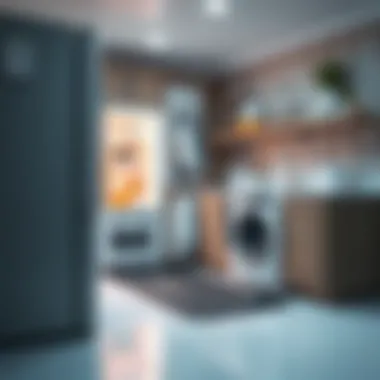
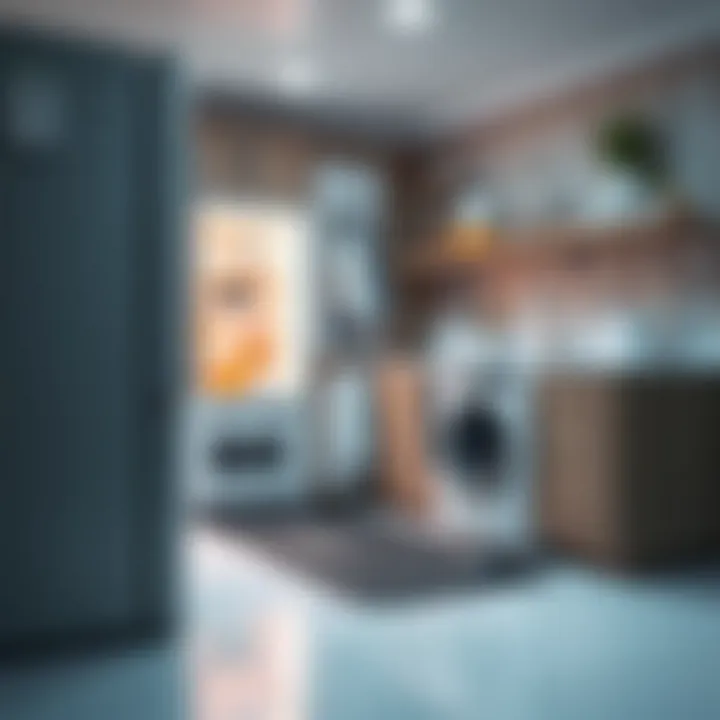
Those attributes are particularly vital for larger refrigerators that run on powerful compressors. Remember, investing in a mat with adequate thickness may save you resources on repairs or replacement of both the mat and your flooring down the line.
Surface Texture and Grip
The texture of the rubber mat plays a key role in its performance, especially regarding grip. A mat with a textured surface is essential to prevent slipping, both for the refrigerator and any items that may occasionally fall off during daily use. Choose a mat with a raised or rubberized pattern to enhance grip and traction.
Additionally, consider a surface that’s easy to clean. A smooth finish might seem appealing, however, it can become slippery when damp. Thus, a textured mat can not only grip well but also allow for easy cleaning, preventing mold and mildew from taking hold.
In summary, focus on selecting a mat that feels secure underfoot and is easy to maintain, as this will keep your kitchen safe and looking sharp over time.
Key Takeaway: Choosing the right rubber mat is a blend of practical measurements and ensuring the product performs its function effectively. Size, thickness, and texture are vital elements that contribute to the overall protection and usability of your refrigerator and kitchen space.
Choosing the appropriate rubber mat boils down to these core considerations. They ensure your mat doesn't just sit there but actually works for you, enhancing the way you enjoy your kitchen setup.
Types of Rubber Mats Available
When it comes to rubber mats under refrigerators, there's a whole array of options available to consumers. Each type offers its own specific benefits, tailored for various needs and environments within a home. This section explores the different types of rubber mats, providing insights on their features, advantages, and considerations that homeowners and designers should keep in mind.
Standard Mats
Standard rubber mats serve as the go-to choice for most households. These mats are relatively simple in design but effective in their primary purpose of providing a smooth surface underneath appliances. Their core benefits include:
- Vibration Control: These mats can noticeably diminish vibrations caused by the refrigerator, reducing noise and potential wear on the appliance over time.
- Moisture Resistance: Standard mats often have inherent moisture barriers, protecting wooden or laminate flooring from potential damage.
- Affordability: One of the most appealing aspects of standard mats is their affordability, making them an accessible option for homeowners on a budget.
However, it’s important to choose a standard mat that's appropriately sized for your refrigerator. A mat that is too small won’t provide adequate coverage, while one that is overly large might be difficult to manage.
Anti-Slip Mats
For those who prioritize safety, anti-slip mats are the ideal selection. These mats feature a textured surface or a unique design aimed at preventing any slipping or sliding of the refrigerator. Key characteristics of anti-slip mats include:
- Enhanced Stability: The grip provided by these mats ensures that your refrigerator stays in place, even on slick flooring.
- Reduced Accidents: Since slipping can lead to accidents, especially in busy kitchens, anti-slip mats help improve safety.
- Variety of Designs: Available in various colors and textures, anti-slip mats can serve as both functional and aesthetic additions to your kitchen’s decor.
An important consideration with anti-slip mats is the compatibility with your flooring. Verify that the mat's structure works well with whatever surface it's laid upon, ensuring maximum grip and stability.
Specialty Mats for Specific Needs
Specialty mats cater to unique circumstances or specific requirements. These mats might be designed for particular appliances, environments, or multifaceted needs. Noteworthy aspects of specialty mats include:
- Heavy-Duty Options: Some specialty mats are engineered for extra-heavy appliances or environments exposed to significant wear and tear.
- Insulated Mats: For those concerned about energy efficiency, insulated mats can help retain cold air better, making the refrigerator work more efficiently.
- Customizable Features: Some specialty mats allow for customization, such as specific dimensions or features that meet a particular requirement.
Specialty mats often come with a higher price tag, so weighing the benefits against the costs based on your needs is essential.
In summary, the type of rubber mat chosen can greatly affect both functionality and safety in your kitchen. Each option has its clear advantages, and understanding these can assist users in making an informed decision that suits their lifestyle and home environment.
Maintenance and Care for Rubber Mats
Taking proper care of rubber mats placed under refrigerators is essential for maintaining their effectiveness and extending their lifespan. Regular maintenance not only ensures the mats perform their job in absorbing vibrations, preventing moisture damage, and protecting the flooring, but also keeps the kitchen environment clean and hygienic. Ignoring the upkeep of these mats can lead to rotting, mildew issues, or even a decrease in their protective capabilities.
Cleaning Methods
Cleaning rubber mats requires some thoughtfulness, as aggressive methods can damage the material. Here are some effective methods for keeping them clean:
- Routine Sweeping or Vacuuming: Start by sweeping or vacuuming the mat regularly to remove dust and debris. This step is simple yet crucial; it prevents the accumulation of dirt that can lead to scratches on the mat’s surface.
- Mild Soap and Water: For deeper cleans, mix mild dish soap with warm water. Use a soft brush or cloth to scrub the mat. It's best to avoid tough scrubbers, as they can scuff the rubber.
- Rinse Thoroughly: After cleaning, ensure that all soap residues are rinsed off. Leftover soap can create a slippery situation when wet.
- Dry Properly: Wipe down the mat with a dry cloth. Ensure it is completely dry before placing any appliances back on it, as dampness can lead to mold growth.
Regular cleaning keeps the mat looking fresh and can extend its lifespan significantly.
Preventing Mold and Mildew
Mold and mildew thrive in moist environments, making refrigeration areas prone to these issues. To prevent mold growth, consider the following strategies:
- Adequate Airflow: Ensure the refrigerator is positioned to allow airflow, particularly around the base. This helps keep the area dry, reducing the likelihood of mold.
- Regular Inspections: Check under the refrigerator and the mat periodically for any signs of moisture. If water is present, identify and fix the source—be it a leak or condensation.
- Use Moisture-Resistant Mats: Consider bars or rubber mats designed specifically for moisture resistance. Mats like those made from nitrile rubber can offer additional protection against humidity.
- Dehumidifiers: In very humid climates, you might find it beneficial to use a dehumidifier in the kitchen. Maintaining lower humidity levels can drastically cut down on mold and mildew development.
Maintaining rubber mats is not merely about cleanliness; it's about creating a healthier kitchen environment, ensuring the longevity of your investments, and safeguarding your home from unnecessary repairs.
Installation Tips for Rubber Mats
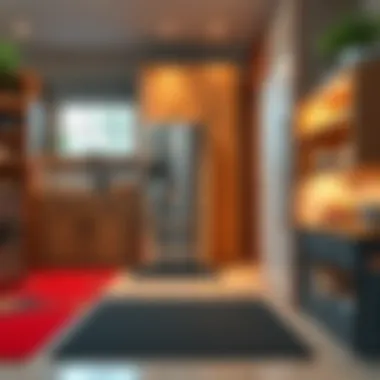

When it comes to rubber mats under refrigerators, a proper installation is crucial for reaping all the benefits these mats can offer. A well-positioned mat can enhance its effectiveness in absorbing vibrations, controlling moisture, and protecting the floors from damage. Thus, understanding the correct installation techniques can not only prolong the life of your mat but also uplift the longevity of your refrigerator. Here, we will go over the two primary stages of installation: preparing the area and positioning the mat.
Preparing the Area
Before placing the rubber mat, it’s vital to get your installation area ready. Here are some key points to consider:
- Clean the Floor: Start by clearing the space beneath the refrigerator. Sweep up any dirt and dust that might have accumulated. Using a damp mop can also help ensure that the floor is spotless. This will prevent particles from getting trapped between the mat and the surface.
- Check for Levelness: Make sure the floor is even. If the ground is a bit uneven, it can lead to instability, which might undermine the effectiveness of the mat. You can do a quick check using a bubble level.
- Assess Moisture Levels: It’s important to make sure there is no water damage or mold in the area where you will be placing the mat. Moisture can foster mold underneath the mat, which defeats its purpose. Repair any leaks in the vicinity before proceeding.
- Allow for Expansion: Make sure the refrigerator is slightly away from the wall. This not only allows for air circulation but also provides space to accommodate the rubber mat without pushing against the refrigerator back.
Positioning the Mat
Once your area is properly prepared, the next step is to position the rubber mat correctly:
- Align with the Fridge Base: Place the mat right under the base of the refrigerator. Ensure that the mat extends a bit further out than the footprint of the refrigerator. This way, any water or condensation that drips will land on the mat instead of your floor.
- Ensure Proper Fit: Some mats come in larger sheets, requiring cutting to fit snugly under your appliance. Use a sharp utility knife or scissors for a clean cut if needed.
- Flat and Smooth: When positioning, make sure there are no wrinkled areas and that the mat sits flat. Bumps and folds can lead to tripping hazards and may reduce its effectiveness at absorbing vibrations.
- Anchor If Needed: If you have an anti-slip mat, it might be beneficial to anchor it down. You can use double-sided tape or adhesive pads to keep it in place. Just be cautious if you choose to apply adhesive; ensure it's removable if you plan on repositioning the mat in the future.
By taking the time to prepare the area and position the mat correctly, you can maximize the life of both your rubber mat and your refrigerator. The installation plays a pivotal role in effectiveness, making your fridge more efficient while safeguarding your floors.
Potential Alternatives to Rubber Mats
When selecting materials to place under refrigerators, it’s crucial to consider not only rubber mats but also other alternatives that can fulfill similar functions. Understanding the available options broadens a homeowner's ability to make informed decisions that suit their specific needs, environments, and budgets. Exploring these alternatives provides insights into their unique strengths and characteristics, allowing you to weigh their benefits against those of rubber mats.
Foam Mats
Foam mats present an intriguing option for individuals seeking both cushioning and floor protection. These mats are often lightweight and easy to handle, making installation a breeze. Unlike rubber, foam has a softer feel underfoot, which can be quite pleasant, especially in a kitchen setting where one might spend a lot of time standing.
Some notable points about foam mats are:
- Shock Absorption: The inherent soft structure of foam mats allows them to absorb impacts well, reducing vibrations produced by the refrigerator. This feature is particularly beneficial in minimizing noise.
- Insulation: Foam provides a layer of insulation against cold air, which can be helpful if the refrigerator is not perfectly sealed, preventing draughts from seeping into the surrounding area.
- Cost-effective: Generally, foam mats are priced lower than rubber mats, providing a more economical option to homeowners who may be on a tight budget.
However, it’s worth noting that foam mats may degrade more quickly than rubber, especially if exposed to water or heavy foot traffic for extended periods. They can also attract dust and dirt, requiring more frequent cleaning to maintain their appearance.
Felt or Cloth Mats
Felt or cloth mats also serve as a possible alternative, adding an aesthetic touch to the often utilitarian kitchen space. These materials can compliment various design schemes and provide a soft underlayment for the refrigerator. Here’s what makes felt or cloth mats valuable:
- Design Variety: Available in a myriad of colors and patterns, felt or cloth mats can enhance the decor of a kitchen, providing a stylish touch that rubber may lack.
- Moisture Absorption: Many felt materials can absorb any moisture that might escape from the refrigerator, although this also means they may require vigilant maintenance to prevent mildew and bacterial growth.
- Comfort: Like foam, cloth mats offer a cushioned feel underfoot, making standing for long periods much more bearable.
Despite these advantages, felt or cloth mats are generally less durable than rubber or foam options. They can wear out more quickly, especially in high-use areas, and may not provide the same level of protection against scratches or dings to the flooring beneath.
In summary, while rubber mats are commonly the go-to choice for their durability and protective qualities, foam and felt or cloth mats represent alternatives that can meet specific needs, offering unique advantages. Careful consideration of these options ensures that homeowners can select a mat that aligns perfectly with both their functional requirements and aesthetic preferences.
Environmental Considerations
The conversation around rubber mats under refrigerators often overlooks the environmental impact of these products. As we increasingly think about sustainability and responsible consumerism, understanding the life cycle of rubber mats is vital. These mats aren’t just practical solutions for protecting your floors; they also come with considerations that affect the planet.
Sustainability of Rubber Products
Sustainability in rubber products hinges on various factors including production methods, material sourcing, and end-of-life management. Rubber mats, when made from natural rubber, can be seen as a friendlier option to the environment.
Natural rubber is derived from the sap of rubber trees, which can regenerate and offer a renewable resource. However, ensuring the sustainability of this supply chain can be tricky. For instance, some rubber plantations can contribute to deforestation if not managed correctly. In contrast, synthetic rubber, often derived from petroleum, raises concerns regarding its environmental toll due to carbon emissions and non-biodegradability.
When selecting rubber mats for your refrigerator, look for certifications like the Forest Stewardship Council (FSC) that indicate sustainable practices. Moreover, products made from recycled rubber represent a significant step towards sustainability, reducing waste while still maintaining utility.
"Choosing rubber mats made from recycled materials can significantly lower your carbon footprint, showcasing your commitment to eco-friendly living."
Disposal Options for Used Mats
Eventually, rubber mats reach the end of their life cycle. Unthoughtful disposal can lead to waste piling in landfills, contributing to environmental degradation. Therefore, knowing how to properly dispose of or recycle these mats is key to minimizing their ecological impact.
Here are some effective disposal options:
- Recycling Programs: Many communities offer recycling programs that accept rubber products. Check with local waste management authorities to find appropriate facilities or drop-off points.
- Creative Reuse: Used rubber mats can find new life in various DIY projects. For instance, they can be cut into pieces for use in gardening, such as pots or pathways, or even as cushioning in exercise spaces.
- Donation: If the mats are still in decent shape, consider donating them to local schools, gyms, or community centers that may benefit from their durability.
The key takeaway is to approach disposal with a mindset of responsibility and creativity. This not only helps mitigate the impact on our environment but also supports a culture of sustainability that will benefit future generations.
By paying attention to these environmental aspects, homeowners and designers can make informed choices that resonate with responsible consumer practices, ensuring that the functionality of rubber mats is in harmony with the wellbeing of our planet.
The End
Wrapping things up, the significance of utilizing rubber mats beneath refrigerators cannot be overstated. These mats are not just an afterthought but central to the functionality and longevity of both the appliance and floor surfaces. By primarily addressing vibration issues, moisture mitigation, and floor protection, rubber mats improve the overall kitchen experience. With the potential for damage lurking around every corner, investing in a quality rubber mat becomes an act of foresight.
Summary of Key Points
- Rubber mats play a pivotal role in dampening vibrations, which can lead to noise reduction and a tranquil home environment. No one enjoys the shuffle-shuffle sound of a moving fridge, and these mats can help curb that.
- They safeguard flooring from moisture damage, which can deteriorate materials over time, leading to potentially costly repairs.
- Choosing the appropriate size, thickness, and texture accelerates the mat's effectiveness, preventing slippage and optimizing its protective qualities.
- Regular maintenance ensures the mats deliver optimal performance throughout their lifespan, keeping them free from contaminants and mold.
- Alternative options exist, such as foam and felt mats, but rubber mats remain superior in terms of durability and effectiveness.















